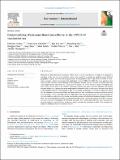| dc.contributor.author | Armas, Federica | |
| dc.contributor.author | Chandra, Franciscus | |
| dc.contributor.author | Lee, Wei Lin | |
| dc.contributor.author | Gu, Xiaoqiong | |
| dc.contributor.author | Chen, Hongjie | |
| dc.contributor.author | Xiao, Amy | |
| dc.contributor.author | Leifels, Mats | |
| dc.contributor.author | Wuertz, Stefan | |
| dc.contributor.author | Alm, Eric J | |
| dc.contributor.author | Thompson, Janelle | |
| dc.date.accessioned | 2023-01-26T18:34:42Z | |
| dc.date.available | 2023-01-26T18:34:42Z | |
| dc.date.issued | 2023-01 | |
| dc.identifier.uri | https://hdl.handle.net/1721.1/147747 | |
| dc.description.abstract | SARS-CoV-2 wastewater-based surveillance (WBS) offers a tool for cost-effective oversight of a population's infections. In the past two years, WBS has proven to be crucial for managing the pandemic across different geographical regions. However, the changing context of the pandemic due to high levels of COVID-19 vaccination warrants a closer examination of its implication towards SARS-CoV-2 WBS. Two main questions were raised: 1) Does vaccination cause shedding of viral signatures without infection? 2) Does vaccination affect the relationship between wastewater and clinical data? To answer, we review historical reports of shedding from viral vaccines in use prior to the COVID-19 pandemic including for polio, rotavirus, influenza and measles infection and provide a perspective on the implications of different COVID-19 vaccination strategies with regard to the potential shedding of viral signatures into the sewershed. Additionally, we reviewed studies that looked into the relationship between wastewater and clinical data and how vaccination campaigns could have affected the relationship. Finally, analyzing wastewater and clinical data from the Netherlands, we observed changes in the relationship concomitant with increasing vaccination coverage and switches in dominant variants of concern. First, that no vaccine-derived shedding is expected from the current commercial pipeline of COVID-19 vaccines that may confound interpretation of WBS data. Secondly, that breakthrough infections from vaccinated individuals contribute significantly to wastewater signals and must be interpreted in light of the changing dynamics of shedding from new variants of concern. | en_US |
| dc.language.iso | en | |
| dc.publisher | Elsevier BV | en_US |
| dc.relation.isversionof | 10.1016/j.envint.2022.107718 | en_US |
| dc.rights | Creative Commons Attribution 4.0 International license | en_US |
| dc.rights.uri | https://creativecommons.org/licenses/by/4.0/ | en_US |
| dc.source | Elsevier | en_US |
| dc.title | Contextualizing Wastewater-Based surveillance in the COVID-19 vaccination era | en_US |
| dc.type | Article | en_US |
| dc.identifier.citation | Armas, Federica, Chandra, Franciscus, Lee, Wei Lin, Gu, Xiaoqiong, Chen, Hongjie et al. 2023. "Contextualizing Wastewater-Based surveillance in the COVID-19 vaccination era." Environment International, 171. | |
| dc.contributor.department | Massachusetts Institute of Technology. Department of Biological Engineering | en_US |
| dc.relation.journal | Environment International | en_US |
| dc.eprint.version | Final published version | en_US |
| dc.type.uri | http://purl.org/eprint/type/JournalArticle | en_US |
| eprint.status | http://purl.org/eprint/status/PeerReviewed | en_US |
| dc.date.updated | 2023-01-26T18:02:43Z | |
| dspace.orderedauthors | Armas, F; Chandra, F; Lee, WL; Gu, X; Chen, H; Xiao, A; Leifels, M; Wuertz, S; Alm, EJ; Thompson, J | en_US |
| dspace.date.submission | 2023-01-26T18:02:45Z | |
| mit.journal.volume | 171 | en_US |
| mit.license | PUBLISHER_CC | |
| mit.metadata.status | Authority Work and Publication Information Needed | en_US |
